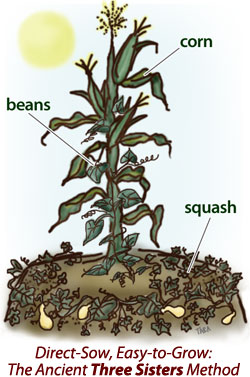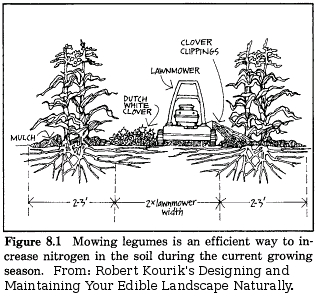
Using legumes to increase the garden's fertility
 Due
to their nitrogen-fixing bacteria, legumes are a great way to break
your garden out of the nitrogen cycle. It's almost like printing
your own money, this ability to create your own usable nitrogen out of
thin air. So how do you put your newfound knowledge to use?
Due
to their nitrogen-fixing bacteria, legumes are a great way to break
your garden out of the nitrogen cycle. It's almost like printing
your own money, this ability to create your own usable nitrogen out of
thin air. So how do you put your newfound knowledge to use?
The first thing to
understand is that your legumes are holding onto
every bit of nitrogen they can. Planting beans beside corn plants
and hoping that the beans will feed the corn is mostly just wishful
thinking --- the beans are going to feed the beans. However, when
nitrogen-fixing plants die, the nitrogen in their bodies will end up
back in the soil, so the next crop will benefit. Take advantage
of this bit of biology by planting spring peas, then follow them with
summer corn.
Legumes also shake off
their nitrogen-fixing nodules when they are stressed by drought, shade,
defoliation, or grazing. Robert
Kourik
suggested planting a row of corn between rows of clover, mowing the
clover, and watching the corn take up the off-loaded nitrogen and
increase its  growth. In fact, for
those of you (like me) who are a bit leery of clover taking over in Fukuoka's
do-nothing clover/grain permaculture, you might get the best of
both worlds by interspersing rows of clover with rows of grain.
growth. In fact, for
those of you (like me) who are a bit leery of clover taking over in Fukuoka's
do-nothing clover/grain permaculture, you might get the best of
both worlds by interspersing rows of clover with rows of grain.
Of course, the most
common method of using legumes to increase a
garden's stores of nitrogen is green manuring. You plant a legume
as a cover crop, then till it into the soil when it is just about to
flower (the stage at which the plant contains the most nitrogen.)
This method, although widespread, is difficult in a no-till garden.
| This post is part of our Nitrogen Fixing lunchtime series.
Read all of the entries: |
Want more in-depth information? Browse through our books.
Or explore more posts by date or by subject.
About us: Anna Hess and Mark Hamilton spent over a decade living self-sufficiently in the mountains of Virginia before moving north to start over from scratch in the foothills of Ohio. They've experimented with permaculture, no-till gardening, trailersteading, home-based microbusinesses and much more, writing about their adventures in both blogs and books.
Want to be notified when new comments are posted on this page? Click on the RSS button after you add a comment to subscribe to the comment feed, or simply check the box beside "email replies to me" while writing your comment.

I tried without any luck to post this in the clover thread.
You might want to try red clover for a cover crop. I did fall before last with these results. The clover came up small in the fall, then grew large in early spring, which I then tilled under as green manure. last summer, not a sign of it, but this fall and winter it came back and now is much larger than it was the first fall (when it got planted late). So it is not a weed during growing season but seeds itself for another year.
(I moved this comment over for you.)
Interesting! I'll have to keep red clover in mind and start experimenting!